Samuel, Books Of
 From Nwe
From Nwe | Books of the Hebrew Bible |
|
The Books of Samuel (Hebrew: ספר שמואל—Sefer Sh'muel) , are part of the Hebrew Bible), or Old Testament. They deal with beginnings of the Hebrew kingdoms of Israel and Judah in the eleventh century, B.C.E.. The main characters in the story are Samuel, Saul, David, and God. The plot traces Samuel's birth and ministry as Israel's last and greatest judge, the anointing and rise of Saul as Israel's first king, the rejection of Saul by God and Samuel, the rise of David, the struggle between Saul and David, the consolidation of David's kingdom after Saul's death, and various intrigues and rebellions within David's realm.
The Books of Samuel originally formed a single text, which probably continued through the first chapters of the current Books of Kings. Due to limitations in the lengths of texts that could be contained in a single scroll, however, they had to be divided. The translators who created the Greek Septuagint version of the Bible divided the text of Samuel and Kings into four books, which they named the Books of the Kingdoms. In the Latin Vulgate version, this was rendered as the Books of the Kings. Thus, the books known today as 1 and 2 Samuel were 1 and 2 Kings, while today's Books of Kings were called 3 and 4 Kings. The modern English designations of Samuel and Kings began with the King James Bible.
While the traditional authorship of the Books of Samuel is ascribed primarily to Samuel himself modern scholarship generally believes that several later sources, some with contradictory views of events, were combined into the books as we have them today.
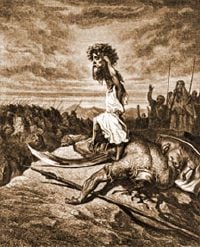
The contents of the books
The two books can be essentially broken down into five parts:
- The period of Yahweh's rejection of Eli, Samuel's birth, and his subsequent leadership of Israel (1 Samuel 1:1-7:17)
- Samuel's interaction with Saul and the early kingship of Saul (1 Samuel 8:1-15:35)
- Saul's later kingship and interaction with David (1 Samuel 16:1-2 Samuel 1:27)
- David's reign, the civil war between Judah and Israel, the intrigues of David's family, and the rebellions against his kingship (2 Samuel 2:1-20:22)
- An appendix of extra material concerning David inserted out of sequence with the rest of the text (2 Samuel 22:1-24:25)
The story weaves the sagas of three separate leaders together, and there is evidence of several sources at work even in telling. For example, the story of Saul's emergence as king is told in three different versions. [1] In addition to combining the stories of Samuel, Saul, and David, the sources display their own theological viewpoints, some strongly opposed to the institution of kingship, others favoring it as a divinely ordained office.
The conclusion of the story begun in the Books of Samuel actually appears in 1 Kings 1-2, dealing with David's old age, the rebellion of Adonijah, Solomon's enthronement, and his enacting a final revenge against David's perceived enemies. The time period and general subject matter of the Book(s) of Samuel is also covered by the narrative in the Books of Chronicles. However this material is less detailed, and many of the stories embarrassing to David, such as the account of his affair with Bathsheba, the civil war with Ish-bosheth, and the rebellion of Absalom, are omitted in that account.
Samuel's birth and ministry
- Story of Hannah (1 Samuel 1)—Hannah, the wife of Elkanah, is childless. She makes a pilgrimage to Shiloh, where she vows that if she has a son, he will be dedicated to Yahweh. The priest of Shiloh, Eli, blesses her, and the child Samuel is soon born. In The Song of Hannah (1 Samuel 2:1-10), Hannah pronounces a poem concerning Yahweh's magnificence that has strong similarities to the later Magnificat of Mary. After weaning Samuel, Hannah brings him to Eli at Shiloh to be raised there, visiting only once a year.
- Eli and his sons (1 Samuel 2)—Eli's sons, Hophni and Phinehas, are also priests at Shiloh, but they abuse their position for personal gain. A prophet tells Eli that because he has failed to prevent his sons from misusing their holy offices, Yahweh has revoked his promise of perpetual priesthood for his family. Eli's sons will die, both on the same day. God will raise up a new priest, "who will do according to what is in my heart and mind."
- The Call of Samuel (1 Samuel 3)—The boy Samuel hears God's voice in the night and confuses it for Eli's. The old priest teaches him how to respond to God's call and receive His message. The prophecy that Samuel makes, however, is a dire one: Eli's lineage will perish, for "The guilt of Eli's house will never be atoned for by sacrifice or offering." Samuel grows up and develops a powerful reputation "from Dan to Beersheba" because of the revelations given to him at Shiloh by Yahweh.
- The Philistine captures the Ark (1 Samuel 4)—The Israelites attack the Philistines at Aphek but are defeated, losing 4,000 men. They decide to gain God's support by bringing the Ark of the Covenant from Shiloh. Nevertheless, when the Philistines attack the Israelite camp at Ebenezer, they prevail and capture the Ark. During the battle, Hophni and Phinehas, attending the Ark, are slain. In Shiloh, Eli hears the news of the battle and falls over in his chair, breaking his neck and dying. His daughter-in-law, Phinehas' wife, goes into labor prematurely and dies after giving birth to a son named Ichabod (without glory).
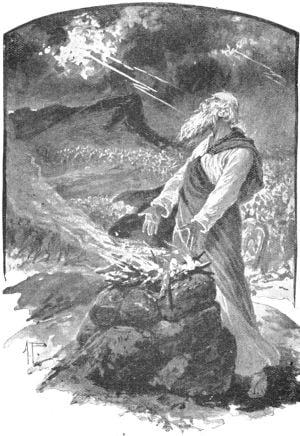
- The Ark among the Philistines (1 Samuel 5-6)—The Philistines take the Ark to Ashdod and place it in the temple of Dagon. The next morning, the statue of Dagon is found prostrate before it. The Philistines set it upright but it is found in pieces the next day. Ashdod falls victim to a plague. The ark is next sent Gath, and then to Ekron, both of which are similarly struck with a plague. On the advice of priests and diviners, the Philistines determine that the plague is no accident and decide to put the Ark on a cow-driven cart and send it off, driverless, toward Israelite territory. It arrives at Beth Shemesh and the locals celebrate. Yahweh, however, kills 70 of the town's residents for daring to look into the sacred vessel. The men of Beth Shemesh ask the people of Kiriath-Jearim to collect the ark, which they do, taking it to the house of Abinadab, where it remains for 20 years.
- The battle of Ebenezer (1 Samuel 7)—Samuel calls the Israelites to repentance and intercedes for the nation at Mizpah. The Philistines attack, but Samuel appeals to Yahweh, and so the Philistines are decisively beaten. Samuel sets up a stone pillar at Ebenezer in memory. The Israelites then recapture the towns and villages between the Philistine strongholds of Ekron and Gath. Thus freed from concerns to the west, the Israelites are also able to make peace with the Amorites to the east.
The rise of Saul
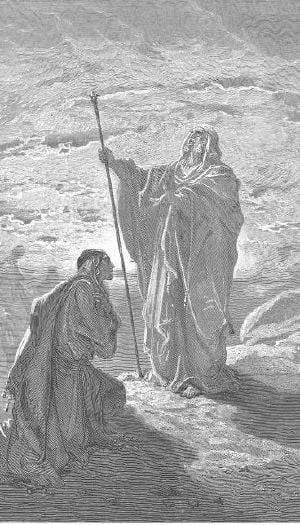
- The appointment of Saul (1 Samuel 8-10)—In Samuel's old age, he appoints his sons, Joel and Abijah, as judges at Beersheba. Much like Eli's sons, however, but they don't follow their father's example. The people clamor for a king. God begrudgingly accedes to their wish and commands Samuel to comply. Meanwhile, the Benjaminie Saul is searching for his father's donkeys. When he reaches Zuph, he seeks out the local "seer," who turns out to be Samuel. The two eat a sacrificial meal together at the high place. Samuel realizes that Saul is the man that Yahweh has chosen to be king, and the next day, anoints him. On the way home, Saul meets a band of ecstatic prophets descending from the high place at Gibeah. Infected by their music and dancing, "the Spirit of God came upon him in power." This leads to the slogan: Is Saul also among the Prophets?[2]
- Saul becomes king (1 Samuel 10)—In what may be a second version of the story of Saul's identification as king, the Israelites gather at Mizpah, where Samuel delivers a sermon preparing the people for the kingship. He is clearly unhappy about the situation, and sees their demand for a king as a rejection of God's leadership.[3] In this story, Saul is not identified by Samuel, but is chosen by lot. Saul, hiding himself in the baggage, seems an unlikely choice except for his height. The people duly shout "Long live the king!" but there is also evidence of division as some in the congregation doubt Saul's abilities. After the ceremonies, nothing much seems to have changed; and everyone, including Saul, simply returns home and lives as before.
- Saul rescues Jabesh-gilead (1 Samuel 11)—The third story of Saul's rise to kingship follows the typical pattern of the Book of Judges, in which a tribal hero emerges through military victory. Saul is home plowing his fields when the Ammonite king, Nahash, lays siege to Jabesh-gilead. Hearing of their plight, Saul slaughters his oxen and sends the pieces to each of the Israelite tribes, calling on them to join him in an attack on Nahash.[4] Saul consequently gathers an army and attacks the Ammonites and Nahash, obliterating his army. The people take this as evidence of Saul's ability to lead, and so consequently they are told by Samuel to confirm him as king at the sacred high place of Gilgal, which they do.
Saul's fall from grace
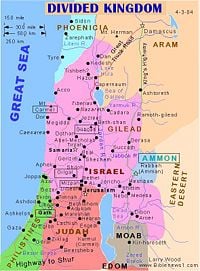
- Saul's rejection at Gilgal (1 Samuel 12-14)—Samuel gives his "farewell speech." The Philistines assemble for a major battle, and Saul waits at Gilgal in accordance with Samuel's instructions, for seven days. After Samuel fails to arrive at the appointed time, Saul's troops begin to desert, so Saul offers a sacrifice. Samuel turns up and castigates Saul for not waiting, telling him that as a result of Saul's sin, his kingdom will not will last.[5]Jonathan emerges as a successful battle leader with strong popular support among the troops. God has not abandoned Saul altogether, as he and Jonathan put the Philistines to flight.
- Saul and the Amalekites. (1 Samuel 15)—Samuel apparently changes his mind about Saul and conveys a message from God commanding Saul to exterminate the Amalekites. Saul devastates them, killing all the Amalekite men, women and children, but does not slaughter the choicest animals, and captures the king, Agag, alive. Saul also erects a victory monument at Mount Carmel, but Samuel berates him for not carrying out the mass extermination of the Amalekites and their cattle completely. Saul repents, pleading that it was merely his intention to offer the animals as a sacrifice to Yahweh, and begs Samuel to stay with him. Samuel refuses and leaves, but Saul grabs at him, tearing part of Samuel's mantel. Samuel declares that Saul's kingdom will likewise be torn from him and given to another. However, Samuel agrees to accompany Saul back to Gilgal, where Samuel kills Agag himself, by hacking him into pieces. Samuel and Saul then part company permanently.
The emergence of David
- David's rise from obscurity (1 Samuel 16-17)—Samuel is told by God to go to Bethlehem, to find a replacement for Saul. There he anoints David, a shepherd and youngest son of Jesse. Yahweh sends an evil spirit to torment Saul, so Saul's servants try to find a harpist to sooth his temper. David, who is skilled with the harp, is thus brought to court and becomes Saul's armor-bearer. The Philistines rally against Israel, putting forth the giant Goliath of Gath as their champion. David, who is bringing provisions to his brothers in Israel's army, speaks against Goliath to his brothers, and Saul overhears him.[6] David persuades the reluctant Saul to let him challenge Goliath. David kills the giant with a single stone from his sling and cuts of his head with the Goliath's own sword. The fleeing Philistines are slaughtered by the Israelites all the way back to Gath.
- David in Saul's court (1 Samuel 18-20)—Jonathan, Saul's son, befriends David, who becomes known as a promising military commander. Women sing David's praises: "Saul has killed his thousands, and David his tens of thousands." Saul grows jealous of David. Seeking to send the young upstart to his death, Saul offers his daughter Michal to him in exchange for 100 foreskins of the Philistines. David, with the aid of his fighting men, returns with double this number, and so weds Michal. Saul, however, now overtly seeks David's life. Both Michal and Jonathan refuse to cooperate with their father's plans, and thus David is spared through their help.
- The priests of Nob (1 Samuel 21-22)—David flees to Ahimelech, priest of Nob, who aids him by giving him sanctified bread as well as the sword of Goliath. Saul's henchman, Doeg the Edomite, however, witnesses this and informs Saul. Saul confronts Ahimilech and insanely orders Doeg to slay him together with 85 priests. Only Ahimelech's son, Abiathar, escapes to tell David.
- Saul's pursuit of David (1 Samuel 22-23)—David has fled to the cave of Adullam, where he amasses a band of outlaws like himself. He leaves his parents in the care of the king of Moab. The prophet Gad tells him to flee, so David moves to the forest of Hereth. David rescues the people of Keilah from the Philistines, but Saul hears of it and sets out against him. Saul chases David into a gorge, but is forced to break off pursuit when the Philistines invade elsewhere and he must fight them.
- David's reconciliation with Saul (1 Samuel 24-25, 26). David hides in the caves near Engedi, and Saul pursues him. Saul enters the cave where David hides, and David sneaks up on him and cuts off the end of his mantle while the king is "relieving himself." David shows himself and convinces Saul that he is not a threat. Samuel meanwhile, dies and is buried, mourned by "all Israel." A second version of the above story is also given, in which David is hiding at Hachilah. Saul searches for him, but David sneaks into camp at night and steals his spear. David leaves the camp and calls out to Saul, once again seeming to convince the king that he is no threat.
- Abigail (1 Samuel 25)—David's men seek hospitality from Nabal, who owns property in Carmel, but Nabal is miserly and refuses. Angered, David prepares to slaughter Nabal and his clan. However, Nabal's clever and pretty wife, Abigail, brings David provisions, urging him not to take vengeance, prophesying great things for him, and convincing him to relent. Nabal is soon struck dead by Yahweh and Abigail becomes David's wife. David also marries Ahinoam of Jezreel. Meanwhile, Michal, his original wife, is transferred by Saul to another man.
- A vassal of Achish (27-29)—David offers his services as a mercenary to the Philistine king of Gath, Achish. David is careful not to attack Israelite settlements, but convinces Achish otherwise. Achish trusts him implicitly, and so requests that David join him in a major attack on Jezreel, against the army of Saul. The Philistines encamp against the Israelites, but some of Achish's captains are uneasy about David's presence. Achish reluctantly agrees to bar David from the fight.[7]
The end of Saul
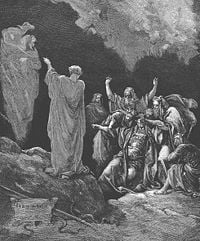
- The Medium of Endor (1 Samuel 28)—Saul sees the Philistines massing against him and is disheartened. He tries to consult God for advice but receives no reply. Although he banned necromancy, Saul disguises himself and goes to a medium at Endor. He asks her to bring up the spirit of Samuel from the dead, which she does. The ghost of Samuel admonishes Saul for disturbing him and tells him again that because of Saul's failure to destroy all of the Amalekites and their cattle, God will by no means support him. Saul is deeply shaken.
- David avenges Ziklag (1 Samuel 30)—Ziklag, the town given to David by the Philistine king, is burnt to the ground by the Amalekites. They, however, do not massacre the women and children of the settlement, taking them captive instead, including David's wives. David and his men set off in pursuit, finally slaughtering all but 400 of the raiders and recovering David's property and wives. David also gains substantial additional spoil, which he shares with his followers, sending a portion to the elders of each of Judah's cities.[8]
- The death of Saul and Jonathan (1 Samuel 33 to 2 Samuel 1)—The Philistines attack the Israelites at Gilboa, inflicting a mortal wound on Saul and killing Jonathan and two of Saul's other sons. Saul asks his armor bearer to finish him off, but he refuses, so Saul falls on his own sword. The Philistines cut the bodies of Saul and his sons into pieces, displaying them on the wall of Beth Shan. However, the inhabitants of Jabesh-gilead later rescue the bodies, cremating them and burying the bones with honor. An Amalekite comes to David and informs him that Saul and Jonathan are dead. The Amalekite boasts that he himself put Saul out of his misery. David orders the messenger's immediate execution and sings a hymn of eulogy to Saul and Jonathan.
David, King of Judah
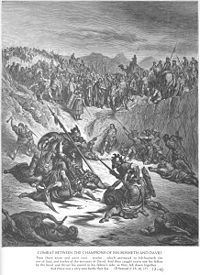
- Ish-boseth (2 Samuel 2-5)—David is anointed king of Judah in Hebron. Saul's son, Ish-bosheth, also called Ishbaal, reigns as Saul's successor over the Israel. Warfare breaks out on a small scale when Ish-bosheth's general, Abner, and David's general, Joab, confront each other at Gibeon. Joab's brother Ashael sets out after Abner, who seeks to avoid combat but finally kills his pursuer. A substantial battle follows, and a long civil war between Judah and Israel ensues, lasting about seven years. Abner eventually has a falling out with Ish-bosheth and decides to change sides. He brings Michal back to David and promises to deliver the whole of the tribe of Benjamin and other northern elements to David's cause. Joab, however, puts an end to Abner's plan when he avenges his brother's death by murdering the northern general. David curses Joab for this, but does not demote him for his crime. Instead, he sings a eulogy to Abner and buries him with honor. Soon Ish-bosheth is assassinated in his sleep by two of his captains. Seeking a reward from David, they cut off their king's head and take it to David at Hebron, where, consistent with his prior behavior, he rewards them by having them executed. This does not prevent him, however, from reaping the benefit of their deed. Still headquartered in Hebron, David is anointed King of Israel. A list of the sons of David born at Hebron and Jerusalem is given in 2 Samuel 3:2-5 and 5:13-16.
- Jerusalem (2 Samuel 5-7)—David sets out for the Jebusite stronghold of Jerusalem and, with Joab in the lead, succeeds in capturing the city. Hiram, king of Tyre, sends master craftsmen to David to build him a palace. The Philistines attack, overrunning the valley of Rephaim, but David defeats them at a place that David names Baal-perazim. A second attack by the Philistines is defeated when David, advised by Yahweh, approaches via the rear, routing the attackers. David then orders that the Ark of the Covenant be moved to Jerusalem. However, it becomes unsteady during transport and a man called Uzzah, who succeeds in steadying it, is struck dead by Yahweh for touching the taboo object. David despairs and decides to leave the Ark at the house of a man named Obed-edom. There it remains for three months until David brings it to Jerusalem with great ceremony and celebration. David's ecstatic dancing during the procession, however, prompts Michal to castigate him for exposing himself, resulting in a permanent estrangement between her and David.[9] David inquires of the prophet Nathan whether the Ark—which serves as the throne of Yahweh—should be housed in grander settings. Nathan at first approves of the plan, but soon receives a revelation in which Yahweh informs him that not David, but one of his sons, will be the one to build a temple for the God of Israel.
- David's vassal states (2 Samuel 8)—David attacks the Philistines, taking some of their territory. He then defeats Moab and executes two thirds of its male population, making Moab a vassal. He then defeats and subjugates "Hadadezer of Zobah" and his Syrian (Aramean) allies. King Toi (or Tou) of Hamath becomes a willing tributary to David. Finally, David becomes famous for slaughtering 18,000 Edomites, after which he stations garrisons in Edom to ensure their compliance with his orders. A list of officers in David's court is given in 2 Samuel 8:16-18 and 20:23-26.
- Mephi-bosheth (2 Samuel 9)—Jonathan had a son named Mephi-bosheth or Meribbaal, crippled in both feet, who was five-years-old when Jonathan and Saul were killed. David shows Meribbaal "kindness," by recognizing his rights to Saul's personal lands and letting him dine at the royal table—thus in effect keeping him under house arrest.[10]
- War with the Ammonites (2 Samuel 10)—The king of the Ammonites dies, and David sends messengers to express condolences. However, they are interpreted as spies, insulted, and sent away. The Ammonites and their allies, including the formerly subdued Arameans, then prepare for war. Joab splits David's army into two groups, one to attack the Aramaeans, and one to attack the Ammonites.
A troubled later-reign
- Bathsheba (11-12)—David sends his army to besiege the Ammonites at Rabbah. Among the leaders of the assault are Joab and Uriahthe Hittite. David falls in love with Uriah's beautiful wife, Bathsheba, and impregnates her. He attempts to cover his sin by having Uriah return and sleep with Bathsheba. When he declines to take such comfort while his troops are in the field, David conspires with Joab to place Uriah in harm's way, and Uriah consequently dies in battle. David marries Bathsheba, but is later confronted by the prophet Nathan for his offense. David repents, but Bathsheba's son nevertheless dies as punishment. A second son is then born to them, Solomon. After Joab has brought Rabbah to the verge of conquest, David rides out to lead the victory, and the bejewelled crown of Milcom is given to David.
- The rape of Tamar (13:1-14:33)—David's son, Amnon, becomes lovesick for his half-sister, Tamar. Feigning illness, he persuades Tamar to feed him at his bedside, rapes her, and immediately rejects her. Tamar complains to her brother, Absalom, but David does not punish Amnon. Two years later, Absalom takes revenge and has Amnon assassinated. Absalom flees to Geshur in Syria. Over time, Joab effects a seeming reconciliation between Absalom and David.
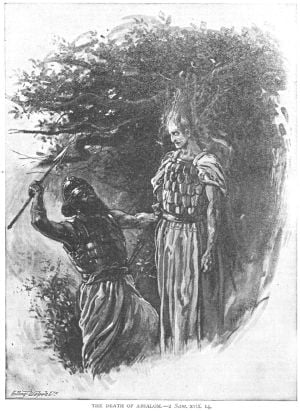
- Absalom's rebellion (15-16)—The handsome and charming Absalom builds up a following, eventually gaining enough supporters to move against David. Both Judahites and elements of the northern tribes rally to Absalom's cause, and David is forced to flee Jerusalem. Absalom's forces occupy the city, and Absalom displays his contempt for David by publicly having sex with the king's concubines. With "all Israel" behind him, Absalom attacks David's forces, who have fled across the Jordan. During the battle, Absalom gets caught in a tree by his hair, where Joab—against David's wishes—kills him. David goes into a deep depression, but finally snaps out of it when Joab confronts him with his failure to act as a true king.
- The Rebellion of Sheba (2 Samuel 19-20)—The northern tribes, energized by Absalom's revolt, unite under a man named Sheba, against David. Apparently still angry with Joab for killing Absalom, David commands Amasa, who had supported Absalom, to command the army in the fight against Sheba. At the great stone in Gibeon, Amasa meets Joab, who stabs Amasa to death and drags his body to the side of the road. Joab then leads the army of Judah and besieges Sheba's Israelite forces at the town of Abel Beth-maachah. A wise woman parlays with Joab from the town walls and soon convinces the townspeople to cut off Sheba's head and throw it over the wall to Joab. Joab then returns to Jerusalem, the rebellion ends, and Joab is once again commander-in-chief of David's armies.
The narrative is taken up again at the beginning of the Books of Kings, after the insertion of the material in the following "appendix."
Appendix
The remainder of the second Book of Samuel consists of material that does not fit into the sequence of the above narrative. It is therefore considered as an appendix of related material inserted in the the scroll of 2 Samuel by later editors.
- Gibeon avenged (2 Samuel 21)—A three-year famine arises which God tells David is the result of Saul having put many of the Gibeonites to death. David asks the Gibeonites what he should do as atonement. In response to their request, David gives seven of Saul's descendants to them, sparing only Mephibosheth, and they are dismembered. Saul's concubine Rizpah, the mother of two of them, uses a sackcloth to protect the remains from scavengers. David collects and buries the bones of Saul and Jonathan at the tomb of Kish. The famine consequently ends.[11]
- The Rephaim (2 Samuel 21:15-22)—Four battles against the Philistines are described, each involving one of the giant sons of Rapha. Goliath is one of these, but he is killed by one of Judah's captains, Elhanan, not David. The king himself almost loses his life to a giant named Ishbi-Benob and is rescued by Joab's brother, Abishai.[12]
- The Song of David (2 Samuel 22)—David sings a victory song, which also constitutes much of Psalm 18. It describes Yahweh as a fire-breathing, lightening-hurling storm deity, who thunders from heaven, mounts the cherubim, and rides on the wind, much like the Canaanite deity Baal.

- David's last words (2 Samuel 23:1-7)—This enigmatic poem purports to be David's last words. Its context, however, is unclear and it ends abruptly, well before David's later conversations and deathbed instructions given in 1 Kings.
- David's Mighty Men (2 Samuel 23:8-24)—Several warriors of David are listed, with a brief summary of some of their deeds. They are called the Thirty and the Three, the latter being named as Josheb-Basshebeth, Eleazar son of Dodai, and Shammah son of Agee. Abishai the brother of Joab is named as chief of the Three. The list of the "Thirty" breaks off after Uriah the Hittite is named.
- The Census of David (2 Samuel 24). Yahweh becomes angry with the people and inspires David to order a census. [13]This, however, is a sin; and Gad, the prophet, tells David that Yahweh has given David three options of punishment: famine, plague, or military defeat. David chooses the plague option. The plague is designated to last until "the end of the time." David buys the land on the spot where the angel of death has halted near Jerusalem, builds an altar upon it, and offers sacrifice. God then withdraws the plague.
Authorship
Traditionally, the authors of the books of Samuel have been held to be the prophets Samuel, Gad, and Nathan. Samuel is believed to have penned the first 24 chapters of the first book. Gad, a companion of David (1 Sam. 22:5), is believed to have continued the history after Samuel's death; and Nathan is believed to have completed it. This scenario is based in 1 Chronicles 29:29, which states:
As for the events of King David's reign, from beginning to end, they are written in the records of Samuel the seer, the records of Nathan the prophet and the records of Gad the seer.
However, this theory is not supported by most modern scholars, who consider that the text is clearly not contemporary with the events described. The sources that modern scholarship considers to have been interlaced to construct 1 & 2 Samuel are:
- The Republican Source: a source with a strong anti-monarchial bias. This source enters the text in the description of Samuel, rather than Saul, ridding the land of the Philistines, and only begrudgingly appointing an individual, chosen by God, to be king, namely Saul.
- The Court History of David: a document covering the history of David's kingship, and referred to explicitly in 1 Chronicles 27:24. This source continuously describes Israel and Judah as two separate kingdoms, with David being the unchallenged king of Judah only. David conquers Saul's son Ish-bosheth, but his reign there is not consolidated. Israel rebels under Abasalom, and David is forced into exile. The army of Judah accompanies him back to Jerusalem, but Israel rebels again under Sheba. Not until the reign of Solomon would the kingdoms be truly united, and that union lasted only one generation.
- The Monarchial Source: a source with a pro-monarchial bias and covering many of the same details as the republican source. This source begins with the divinely appointed birth of "Samuel" (many scholars think this passage originally referred to Saul). It describes Saul as becoming king as a result of his leading a war against the Ammonites. God's love for David and his promise to David's descendants are strong themes here, while there is no hint of God's disapproval of the kingship per se as in the "Republican Source."
- The Sanctuaries Source: a relatively short source dealing mainly with the capture of the Ark—here described as residing at Shiloh—by the Philistines, and their subsequent voluntary return of it.
- The Jerusalem source: a fairly short source briefly discussing David conquering Jerusalem from the Jebusites.
- Redactions: additions by the redactor to harmonize the sources together; many of the uncertain passages may be part of this.
- Various: several short sources, which have little connection to each other, and are fairly independent of the rest of the text. Examples include, genealogies, lists of military officers, poems, and the "appendix" material.
The relationship between these sources is uncertain, though it is generally agreed that many of the various shorter sources were embedded into the larger ones before these were in turn redacted together. Based on the documentary hypothesis, some—most recently Richard Elliott Friedman—have proposed that the sources were originally parts of the same texts as the Elohist, Yahwist, and possibly Priestly sources of the Torah. The priestly source, for example, is thought to correlate to the Republican Source, while the Yahwist source correlates to Court History of David. Many scholars believe the Deuteronomist, or those associated with him, is the one who redacted together these sources into the Books of Samuel.
A suggested assignment of the verses to these sources, in their supposed historical order, is:
- Jerusalem Source: 2 Samuel 5:6-16, 6:9-20
- Republican Source: 1 Samuel 9:1-10:16, 11:1-11, 11:15, 13:1-14:52, 16:14-23, 18:6-11, 18:20-27, 19:11-21:1, 21:11-16, 25:1b-25:43, 28:3-25, 31:1-13, 2 Samuel 1:1-5, 1:8-12, 2:1-3:1, 3:6-33a, 3:34b-5:2, 5:17-25, 21:15-22
- Court History of David: 2 Samuel 9:1-20:26, 1 Kings 1:1-2:46
- Sanctuaries Source: 1 Samuel 4:1-7:1
- Monarchial Source: 1 Samuel 1:1-3:21, 8:1-22. 10:17-24, 17:1-18:5, 18:12-19, 18:28-19:10, 21:2-10, 22:1-23, 26:1-28:2, 29:1-30:31, 2 Samuel 1:6-7, 1:13-16
- Redactions: 1 Samuel 2:27-36, 7:2b-16, 11:12-14, 12:1-25, 15:1-35, 2 Samuel 7:1-29
- Various: 2 Samuel 1:17-27; 3:2-5; 3:33b-34a; 22:1-51; 23:1-7; 23:8-24a; 23:24b-39; 24:1-25
- Uncertain: 1 Samuel 7:2a, 7:17, 10:25-27, 16:1-13, 23:1-25:1a, 2 Samuel 6:1-8, 6:21-23, 8:1-18, 21:1-14
Notes
- ↑ Biblical literalists insist that these three tales are merely three stages of Saul's anointing by Samuel, his recognition by the people, and his confirmation through military leadership.
- ↑ However, 1 Samuel 10:12 provides an alternative explanation for the apparently well known saying about Saul being among the prophets. In this version, Saul seeks David's life, but is overcome by the spirit of prophecy and lies naked in ecstasy before David's protector, Samuel, instead.
- ↑ Coincidentally, Samuel himself will no longer by Israel's primary human leader, nor will his sons succeed him in the office of judge.
- ↑ The episode is reminiscent of Judges 19, where an unnamed Levite summons the Israelites to war by cutting the murdered body of his own concubine into 12 pieces and sending one to each of the tribes. In that case, however, the other Israelites make war against the tribe of Benjamin. Here, the situation is reversed, as the Benjaminite Saul unites the Israelites in war against the Ammonites.
- ↑ The cause for God's rejection of Saul here is apparently his usurpation of the priestly office, although Israelite kings offered sacrifices without priestly aid in other contexts.
- ↑ In this version of the story, clearly from a different source, Saul has not previously met David.
- ↑ Some scholars suggest that the biblical narrative goes far out of its way to make David's alliance with the Philistines palatable. The Philistines, after all, were the Israelites' mortal enemy, whom David had earlier slaughtered by the hundreds with no compunction. Likewise, David's refraining from killing Saul on two occasions and his public mourning of Saul's death leaves some readers incredulous.
- ↑ This would stand him in good stead with the Judahite leaders, who later nominated him king at Hebron.
- ↑ The text indicates that she had no children until she died. An alternative reading is therefore that Michal was made permanently infertile for speaking out against the king.
- ↑ A story given in the "appendix" indicates that David had earlier handed all of Saul's other descendants over to the Gibeonites for execution.
- ↑ The story seems to be at odds with the earlier account in which David seeks to show kindness to Saul's house and is unaware of Mephibosheth.
- ↑ This narrative fits well with the story of the Philistine victory over David's forces in the "valley of Rephaim," shortly after David's taking Jerusalem.
- ↑ In 1 Chronicles 21, it is not God who moves David to this action, but Satan.
References
ISBN links support NWE through referral fees
- Bright, John. A History of Israel. Westminster John Knox Press; 4th edition, 2000. ISBN 0664220681
- Dever, William G. Who Were the Early Israelites and Where Did They Come From? William B. Eerdmans Publishing Co., 2003. ISBN 0802809758
- Finkelstein, Israel, and David Silberman. David and Solomon: In Search of the Bible's Sacred Kings and the Roots of the Western Tradition. New York: Free Press (Simon and Schuster), 2006. ISBN 0743243625
- Friedman, Richard E. Who Wrote The Bible? Harper and Row, 1987. ISBN 0060630353
- Grant, Michael. The History of Ancient Israel. Charles Scribner's Sons, 1984. ISBN 0684180812
- Keller, Werner. The Bible as History. Bantam, 1983. ISBN 0553279432
- Kirsch, Jonathan. King David: the real life of the man who ruled Israel. Hendersonville, TN: Ballantine, 2000. ISBN 0345432754.
- Laymon, Charles M. The Interpreter’s One-Volume Commentary on the Bible. Abingdon Press, 1971. ASIN B000J53AMG
- Mazar, Amihai. The Archeology of the Land of the Bible. Anchor, 1992. ISBN 978-0385425902
- Miller, J. Maxwell. A History of Ancient Israel and Judah. Westminster John Knox Press, 1986. ISBN 066421262X
- Pinsky, Robert. The Life of David. New York: Schocken, 2005. ISBN 0805242031
- Rosenberg, David. The Book of David: A New Story of the Spiritual Warrior and Leader Who Shaped Our Inner Consciousness. New York: Harmony, 1997. ISBN 0517708000
External links
All links retrieved December 22, 2022.
- Translation with Rashi's commentary – www.Chabad.org
- Books of Samuel – Jewish Encyclopedia.
|
|||||||||||||||||||||||
Credits
New World Encyclopedia writers and editors rewrote and completed the Wikipedia article in accordance with New World Encyclopedia standards. This article abides by terms of the Creative Commons CC-by-sa 3.0 License (CC-by-sa), which may be used and disseminated with proper attribution. Credit is due under the terms of this license that can reference both the New World Encyclopedia contributors and the selfless volunteer contributors of the Wikimedia Foundation. To cite this article click here for a list of acceptable citing formats.The history of earlier contributions by wikipedians is accessible to researchers here:
- Samuel, Books of history
The history of this article since it was imported to New World Encyclopedia:
- History of "Samuel, Books of"
Note: Some restrictions may apply to use of individual images which are separately licensed.
↧ Download as ZWI file | Last modified: 02/06/2023 09:30:02 | 269 views
☰ Source: https://www.newworldencyclopedia.org/entry/Samuel_(Books_of) | License: CC BY-SA 3.0
 ZWI signed:
ZWI signed: KSF
KSF